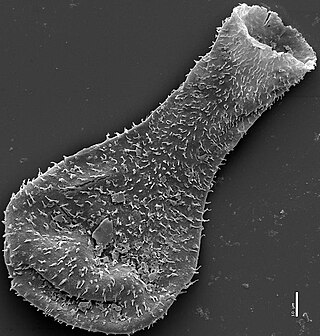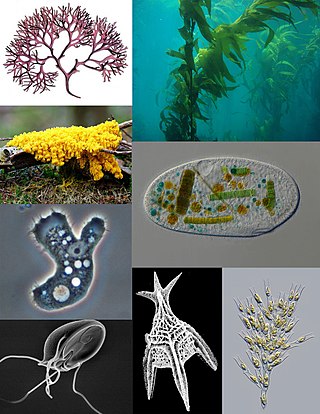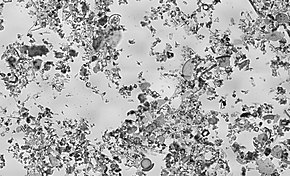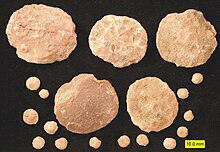
Acritarchs are organic microfossils, known from approximately 1800 million years ago to the present. The classification is a catch all term used to refer to any organic microfossils that cannot be assigned to other groups. Their diversity reflects major ecological events such as the appearance of predation and the Cambrian explosion.

Invertebrate paleontology is sometimes described as invertebrate paleozoology or invertebrate paleobiology. Whether it is considered to be a subfield of paleontology, paleozoology, or paleobiology, this discipline is the scientific study of prehistoric invertebrates by analyzing invertebrate fossils in the geologic record.

Palynology is the study of microorganisms and microscopic fragments of mega-organisms that are composed of acid-resistant organic material and occur in sediments, sedimentary rocks, and even some metasedimentary rocks. Palynomorphs are the microscopic, acid-resistant organic remains and debris produced by a wide variety plants, animals, and Protista that have existed since the late Proterozoic.

Coccoliths are individual plates or scales of calcium carbonate formed by coccolithophores and cover the cell surface arranged in the form of a spherical shell, called a coccosphere.

Foraminifera are single-celled organisms, members of a phylum or class of Rhizarian protists characterized by streaming granular ectoplasm for catching food and other uses; and commonly an external shell of diverse forms and materials. Tests of chitin are believed to be the most primitive type. Most foraminifera are marine, the majority of which live on or within the seafloor sediment, while a smaller number float in the water column at various depths, which belong to the suborder Globigerinina. Fewer are known from freshwater or brackish conditions, and some very few (nonaquatic) soil species have been identified through molecular analysis of small subunit ribosomal DNA.

Chitinozoa are a group of flask-shaped, organic walled marine microfossils produced by an as yet unknown organism. Common from the Ordovician to Devonian periods, the millimetre-scale organisms are abundant in almost all types of marine sediment across the globe. This wide distribution, and their rapid pace of evolution, makes them valuable biostratigraphic markers.

A microfossil is a fossil that is generally between 0.001 mm and 1 mm in size, the visual study of which requires the use of light or electron microscopy. A fossil which can be studied with the naked eye or low-powered magnification, such as a hand lens, is referred to as a macrofossil.
Dinocysts or dinoflagellate cysts are typically 15 to 100 µm in diameter and produced by around 15–20% of living dinoflagellates as a dormant, zygotic stage of their lifecycle, which can accumulate in the sediments as microfossils. Organic-walled dinocysts are often resistant and made out of dinosporin. There are also calcareous dinoflagellate cysts and siliceous dinoflagellate cysts.
Alfred Eisenack was a German paleontologist. He was a pioneer of micropaleontology and palynology. His botanical and mycological author abbreviation is "Eisenack".

The Micropalaeontological Society (TMS) is a scientific society based in the UK with international membership. It was founded in 1970 for the promotion of the study of micropalaeontology, the study of microscopic fossils.

Helen Niña Tappan Loeblich was an American micropaleontologist who was a professor of geology at the University of California, Los Angeles, a United States Geological Survey (USGS) biostratigrapher, and a scientific illustrator whose micropaleontology specialty was research on Cretaceous foraminifera.
Circulisporites is a genus of plants. It is known from Triassic spores and pollen grains from the Ipswich coalfield in Queensland, Australia.
Edith Kristan-Tollmann nee Edith Kristan was an Austrian geologist and paleontologist. A prolific scientist with an interest in micropalaeontology and especially the foraminifera of the Triassic and the Jurassic eras, Kristan-Tollmann published widely in her field. She is also known for originating with her husband Alexander Tollmann a thoroughly documented theory of the evolution of human legend and social structures as a result of a massive impact event which struck multiple points on earth. The latter has become known as Tollmann's hypothetical bolide.

The Marne di Monte Serrone is a geological formation in Italy, dating to roughly between 181 and 178 million years ago, and covering the early and middle Toarcian stage of the Jurassic Period of central Italy. It is the regional equivalent to the Toarcian units of Spain such as the Turmiel Formation, units in Montenegro, such as the Budoš Limestone and units like the Tafraout Formation of Morocco.

Many protists have protective shells or tests, usually made from silica (glass) or calcium carbonate (chalk). Protists are a diverse group of eukaryote organisms that are not plants, animals, or fungi. They are typically microscopic unicellular organisms that live in water or moist environments.
Bridget S. Wade is a British micropalaeontologist who is a professor at the University College London. Her research considers Cenozoic climate change, which she investigates by studying preserved planktonic foraminifera. Wade was a guest on the 2020 Royal Institution Christmas Lectures.

Foraminiferal tests are the tests of Foraminifera.

A protist is any eukaryotic organism that is not an animal, plant, or fungus. While it is likely that protists share a common ancestor, the last eukaryotic common ancestor, the exclusion of other eukaryotes means that protists do not form a natural group, or clade. Therefore, some protists may be more closely related to animals, plants, or fungi than they are to other protists. However, like algae, invertebrates and protozoans, the grouping is used for convenience.
Global paleoclimate indicators are the proxies sensitive to global paleoclimatic environment changes. They are mostly derived from marine sediments. Paleoclimate indicators derived from terrestrial sediments, on the other hand, are commonly influenced by local tectonic movements and paleogeographic variations. Factors governing the Earth's climate system include plate tectonics, which controls the configuration of continents, the interplay between the atmosphere and the ocean, and the Earth's orbital characteristics. Global paleoclimate indicators are established based on the information extracted from the analyses of geologic materials, including biological, geochemical and mineralogical data preserved in marine sediments. Indicators are generally grouped into three categories; paleontological, geochemical and lithological.

Palynodinium is an extinct genus of organic-walled dinoflagellate cyst. It is a fossil species of dinoflagellate cyst used to demarcate the K/Pg boundary, which marks the terminal Cretaceous and the extinction of the dinosaurs. Palynodinium grallator was among the microfossils which lead to the recent discovery of the K/Pg event record in marine sediments of the northeast Pacific.


















